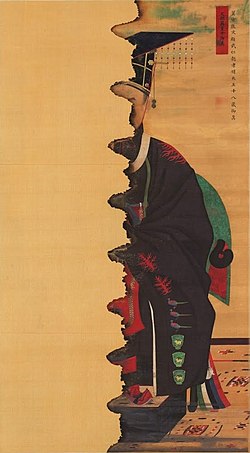Crown Prince Hyomyeong
| Crown Prince Hyomyeong 효명세자 | |
|---|---|
 Portrait of Crown Prince Hyomyeong, damaged during the 1954 Busan Yongdusan fire | |
| Regent of Joseon | |
| Tenure | 17 January 1827 – 6 May 1830 |
| Monarch | Sunjo of Joseon |
| Crown Prince of Joseon | |
| Tenure | 6 July 1812 – 6 May 1830 |
| Predecessor | Crown Prince Yi Gong |
| Successor | Crown Prince Yi Cheok |
| Born | 18 September 1809 Daejojeon Hall, Changdeokgung, Hanseong, Joseon |
| Died | 25 June 1830 (aged 20) Huijeongdang Hall, Changdeokgung, Hanseong, Joseon |
| Spouse | Queen Sinjeong |
| Issue | Heonjong of Joseon |
| Clan | Jeonju Yi |
| Dynasty | Yi |
| Father | Sunjo of Joseon |
| Mother | Queen Sunwon |
| Korean name | |
| Hangul | 효명세자 |
|---|---|
| Hanja | 孝明世子 |
| Revised Romanization | Hyomyeong Seja |
| McCune–Reischauer | Hyomyŏng Seja |
| Birth name | |
| Hangul | 이영 |
| Hanja | 李旲 |
| Revised Romanization | I Yeong |
| McCune–Reischauer | I Yŏng |
Crown Prince Hyomyeong (18 September 1809 – 25 June 1830), personal name Yi Yeong, and posthumously honored as King Munjo, was a member of the Joseon dynasty.
Life and death
[edit]The prince was the eldest son of King Sunjo, husband of Queen Sinjeong and father of King Heonjong.[1]
In 1817, the prince was admitted to the Sungkyunkwan. In 1819, he was titled Crown Prince of Joseon. A genius in literature and the arts, he created several court dances (정재) and used court ritual and the arts to validate and augment the King's control over the government.
Hyomyeong first became active in politics when he was only 17, due to his father being ill. Known to have pursued various political reforms, the prince served as Regent in 1827 until his death 3 years later at age 20.[2]
He did have some enemies amongst his maternal relatives, but avoided nepotism and was a talented writer, composer and choreographer.
Legacy
[edit]The prince was commemorated in an album of six scenes created to celebrate the commencement of his learning at the Songgyungwan, one of a number of documentary paintings (gungjung girokhwa) of the Joseon period.[3]
Among 53 Joseon jeongjaes (정재) or court dances which remain, 26 are his works. His "Chunaengjeon" (Dance of the Spring Nightingale) is the best known and most beloved traditional court dance for its gentle and poetic movements. He was one of the most important people in Korean Court ritual history, along with King Sejong.
His full posthumous name
[edit]Crown Prince Hyomyeong has the longest posthumous name for a member of nobility of Korea.
- English: Crown Prince Chewon Chanhwa Seokgeuk Jeongmyeong Seongheon Yeongcheol Yeseong Yeon-gyeong Yungdeok Sun-gong Dokhyu Hong-gyeong Hong-un Seongryeol Seon-gwang Junsang Yoheum Sun-gong U-geun Tangjeong Gyecheon Geontong Sinhun Geondae Gonhu Gwang-up Yeongjo Jang-ui Changryun Haeng-geon Baenyeong Gitae Suyu Huibeom Changhui Ipgyeong Hyeongdo Seongheon Sojang Goeng-yu Sinhwi Suseo Ubok Donmun Hyeonmu In-ui Hyomyeong the Great[citation needed]
- Korean: 체원찬화석극정명성헌영철예성연경융덕순공독휴홍경홍운성렬선광준상요흠순공우근탕정계천건통신훈숙모건대곤후광업영조장의창륜행건배녕기태수유희범창희입경형도성헌소장굉유신휘수서우복돈문현무인의효명대왕
- Hanja: 體元贊化錫極定命聖憲英哲睿誠淵敬隆德純功篤休弘慶洪運盛烈宣光濬祥堯欽舜恭禹勤湯正啓天建通神勳肅謨乾大坤厚廣業永祚莊義彰倫行健配寧基泰垂裕熙範昌禧立經亨道成獻昭章宏猷愼徽綏緖佑福敦文顯武仁懿孝明大王
Family
[edit]- Father: King Sunjo of Joseon (조선 순조; 29 July 1790 – 13 December 1834)
- Grandfather : King Jeongjo of Joseon (조선 정조; 28 October 1752 – 18 August 1800)
- Grandmother : Royal Noble Consort Su of the Bannam Park clan (수빈 박씨; 8 May 1770 – 26 December 1822)
- Mother: Queen Sunwon of the Andong Kim clan (순원왕후 김씨; 8 June 1789 – 21 September 1857)
- Grandfather : Kim Jo-sun (김조순; 1765–1832)
- Grandmother : Internal Princess Consort Cheongyang of the Cheongsong Shim clan (청양부부인 청송 심씨; 1766–1828)
- Consorts and their Respective Issue(s):
- Queen Sinjeong of the Pungyang Jo clan (신정왕후 조씨; 21 January 1809 – 4 June 1890)
- King Heonjong of Joseon (조선 헌종; 8 September 1827 – 25 July 1849)
In popular culture
[edit]- Portrayed by Park Bo-gum in the 2016 KBS2 TV series Love in the Moonlight.
- Portrayed by Kim Min-jae in the 2018 film Feng Shui.
- Portrayed by Gong Myung in the 2021 SBS TV Series Lovers of The Red Sky.
See also
[edit]- Crown Prince Hyomyeong and Court Dancing[permanent dead link]
- Hyomyeong, The Crown Prince Who Loved Dancing
- Reenactment of Crown Prince Hyomyeong's Sungkyunkwan Admission Ceremony
References
[edit]- ^ 효명세자. National Culture. Archived from the original on 2016-04-05.
- ^ 18살에 급서한 효명세자 '문조'로 거한 대우를 받다. Donga Weekly. 31 January 2011.
- ^ 동궐도에 숨어있는 효명세자에 대한 배려. Kyobo Story.

